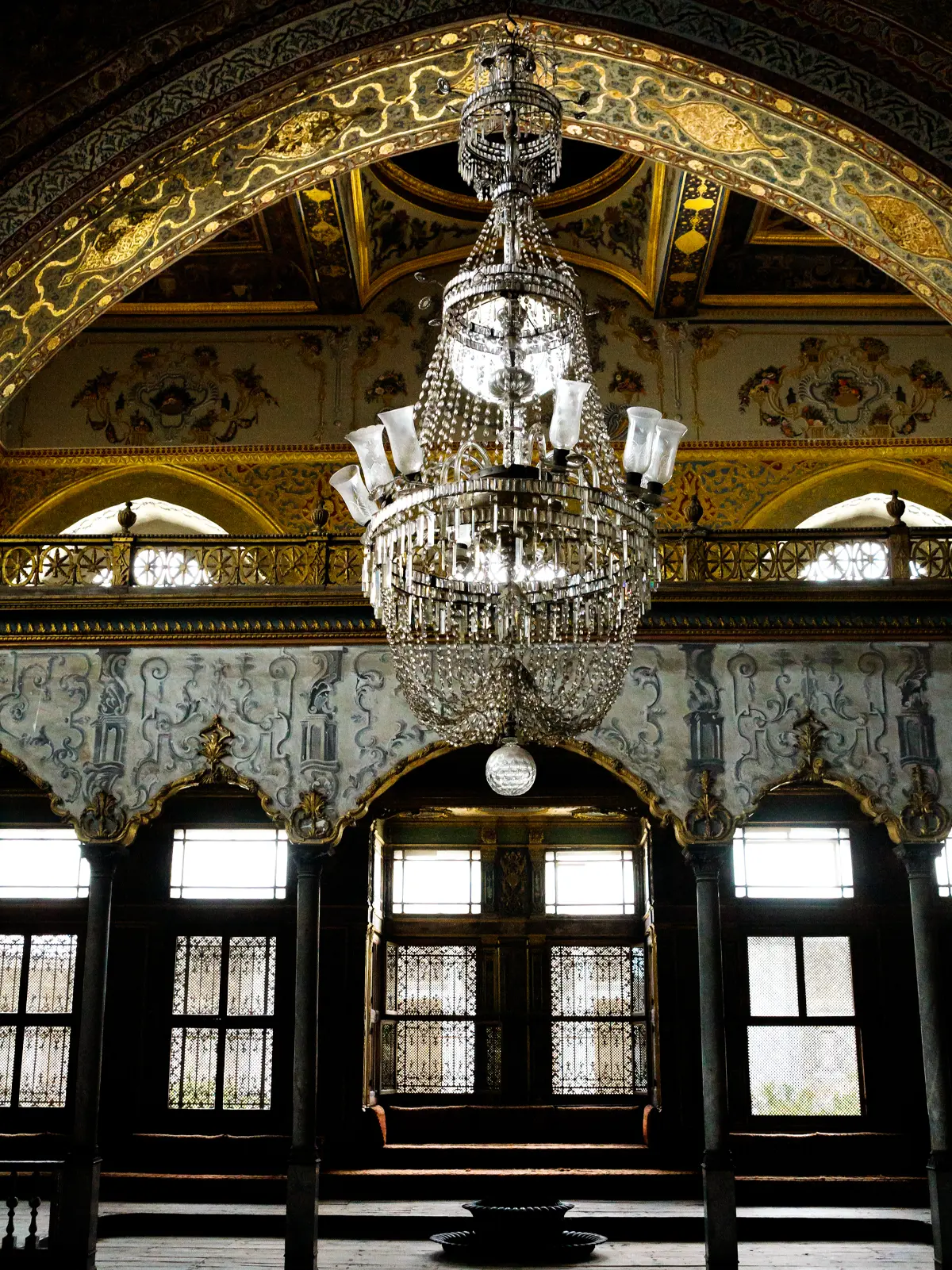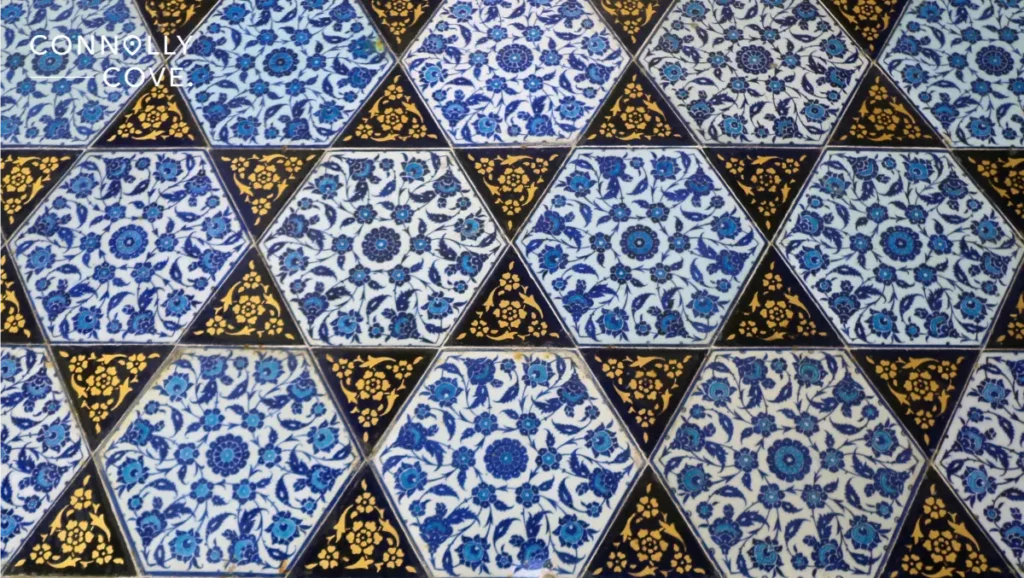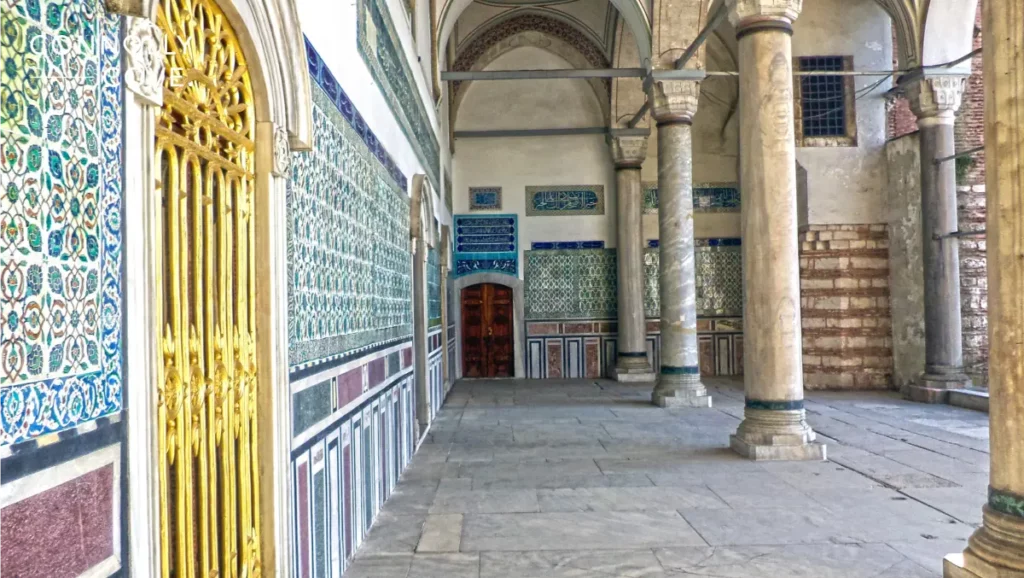Topkapı Palace: A Magical Journey Through Its 4 Courtyards

Updated On: April 15, 2024 by Fatma Mohamed
Imagine yourself transported back to the heart of an empire, where Topkapı Palace, with its opulent chambers, whisper tales of sultans and sultanas, and intricate tilework, reflects the dazzling glory of a bygone era. Welcome to the Topkapı Palace, a UNESCO World Heritage Site and Istanbul’s crown jewel, where centuries of Ottoman history unfold step by step.
For over 400 years, this magnificent complex served as the administrative power centre of the mighty Ottoman Empire. Today, transformed into a captivating museum, the Topkapı Palace beckons you to embark on a journey through time, revealing a treasure trove of art, artefacts, and stories waiting to be discovered.
In this article, we will uncover this extraordinary palace, encompassing four main courtyards adorned with exquisite tilework and breathtaking views of the Bosphorus Strait. So, join us on this journey to discover the majesty of Topkapı Palace. Let’s start!
Table of Contents
A Timeless Architectural Marvel
Marvel structure stretched almost 700,000 square metres with a maze of courtyards, gardens, and luxurious artefacts within historic walls. So, let’s delve more into the most important features of this marvellous palace.
Location
This marvellous Topkapı Palace is located on the Sarayburnu (Seraglio Point), which overlooks both the Marmara Sea and the Bosphorus Strait in the historical Fatih District of İstanbul.
History and Date of Construction

This remarkable palace has a rich history that goes back to 1459. It saw many modifications and expansions throughout its long history, and the original construction is credited to Sultan Mehmed II, also known as Mehmed the Conqueror. He ordered the palace’s construction as a symbol of Ottoman power to establish a grand seat of governance for his newly expanded empire.
Over two decades, builders blended Ottoman, Byzantine, and Islamic architectural influences, shaping the palace into a marvel of stone and tile. By 1478, Topkapı stood complete, ready to witness centuries of sultans, ceremonies, and Ottoman history within its walls.
From administrative centre to museum, Topkapı’s story continues to unfold, offering a glimpse into the rise and fall of an empire etched in every corner of its timeless architecture.
A Journey Through Topkapı’s Gates and Four Courtyards
The Imperial Gate of the Topkapı Palace in Turkish is called Bab-I Hümayun. Stepping through the entrance gate leading to the first courtyard of Topkapı Palace is a royal experience that will amaze you. This bustling public arena served as the gateway to the imperial world.
First Court
Largest, liveliest, and open to all – that’s the First Courtyard. Ceremonies and processions strutted their stuff here, with even commoners catching a glimpse of Ottoman power. No wonder it earned nicknames like “Janissary Court” or “Parade Court”!
This first court also served as a waiting area for horses and servants of visiting dignitaries. It houses the Hagia Irene Museum, a Byzantine church converted into a museum and the Fountain of Sultan Ahmet III, a rococo masterpiece showcasing Ottoman artistic achievement.
Second Court
Pass through the ornate Middle Gate, which is named Bab-ı Selam, meaning “Gate of Salutation” or “Gate of Peace”, and step into the heart of the palace in the Second Court. Welcome to the Second Court, also known as the House of Salutation, the true heart of the palace.
Here, power pulsed. In the Divan, viziers strategised under the sultan’s watchful gaze. Armies were readied in the Armory, their glinting weapons an unspoken declaration.
But power wasn’t all that graced this space. Intricate clocks adorned the Clock Pavilion, a testament to the empire’s fascination with timekeeping. Hidden behind discreet walls lay the entrance to the Harem, offering a glimpse into the lives of sultanas and concubines.
Third Court
Ascend the Gate of Felicity, which is Bab’üs Sa’ade, enter the tranquil realm of the Third Court. Hidden beyond this gate lay the Third Court, the heart of the Topkapı Palace and the sultan’s private domain. Nicknamed the Inner Palace, it was a world away from the public spaces. Imagine lush gardens, opulent chambers, and the hushed whispers of secrets within its secluded walls.
Fourth Court
Finally, climb the Has Oda Gate and reach the verdant serenity of the Fourth Court. Commanding breathtaking views of the Bosphorus and the Sea of Marmara, this private haven offered solace and leisure for the sultans. These include the Mecidiye Kiosk, which was built by Abdülmecit according to 19th-century European styles and served as a perfect escape for contemplation and relaxation.
The Harem
It is a journey through a forbidden realm where sultanas and concubines reside. Imagine hushed conversations and elaborate rituals within chambers adorned with mother-of-pearl inlay and gilded cages.
The Treasury
Immerse yourself in the glittering world of Ottoman power. Marvel at the Topkapı Dagger, its legendary gem-encrusted hilt whispering tales of intrigue. Feast your eyes on dazzling jewellery, ornate weaponry, and priceless manuscripts, each a testament to the empire’s vast wealth and artistic heritage.
Topkapı Palace in the Modern World
Today, Topkapı Palace stands not just as a monument but as a living bridge between past and present. It embodies the enduring legacy of Ottoman power and cultural heritage, drawing millions of visitors to Istanbul annually.
Beyond simply sightseeing, the palace fosters cultural exchange, allowing visitors to step into the heart of an empire and connect with the artistry, traditions, and stories that have shaped a region for centuries. Interactive exhibits, multilingual audio guides, and captivating performances breathe life into the past, making history an immersive experience.
As the museum evolves, future possibilities tantalise the imagination. Imagine VR tours immersing you in the daily lives of sultans or uncovering digital reconstructions of lost palace sections. Perhaps in-depth workshops could unlock the secrets of Ottoman calligraphy or tilework, passing on these traditions to a new generation.
So, why not become a part of its ever-unfolding story? Visit Topkapı Palace, wander its courtyards, and lose yourself in the whispers of history. You might just be surprised by what you discover about the Ottomans, about yourself, and about the enduring power of the human spirit to create beauty and wonder.

The stories haven’t ended; Topkapı Palace awaits your arrival!
Visitor Information Guide
Opening Hours: The palace welcomes visitors during its work hours, 9:00: 18:00 on Wednesday to Monday. Plan your trip according to the season, as opening hours may differ slightly between winter and summer.
Ticket Prices: 1500 Turkish Liras grants you access to the museum’s indoor and outdoor areas, the Harem Rooms, and the Hagia Irene Church. Discounted tickets are available for certain categories.
Getting There: As this incredible palace is located in the heart of Istanbul, so there are several ways to get there. If you were in Sultanahmet Square, you could easily walk to the palace in only 5 minutes. You can also take the tram and get off at either Gülhane station or Sultanahmet station. Both stops are 7 minutes away from Topkapi Palace. Another option is available, which is to get there by train. The nearest train station to the palace is Marmaray Sirkeci Station.
Four Nearby Gems
1. Aya Sofya (Hagia Sophia): Marvel at the architectural wonder, now a stunning mosque. Just across the park from Topkapi Palace, Aya Sofya isn’t just a neighbour; it’s a dazzling neighbour! Gaze in awe at its towering dome and shimmering mosaics, whispering tales of Byzantine emperors and Ottoman sultans. Step inside and feel the weight of centuries of prayers echoing in its cavernous space.
2. Grand Bazaar: Lose yourself in the labyrinthine alleys of this vast shopping earthly paradise . This marvellous bazaar is considered one of the oldest and largest covered shopping markets in the world. Visitors will have the chance not just to shop all they need but also to enjoy the Turkish and Ottoman traditions and culture in this extraordinary bazaar.
3. Gülhane Park: Craving fresh air and breathtaking vistas after delving into palace history? Gülhane Park, nestled beside Topkapı, awaits! Spread a picnic under shady trees, soak in panoramic views of the Bosphorus, and breathe easy alongside ancient city walls. A serene gem just steps away from palace grandeur.
4. Spice Bazaar: Immerse your senses in the vibrant colours and aromas of aromatic spices. Haggle with friendly vendors, stock up on culinary
treasures, and savour the vibrant atmosphere just moments from the palace gates. Prepare for a feast for the senses, not just the stomach! Additionally, you can take a ferry ride on the Bosphorus Strait for breathtaking views of the palace and beyond!
Let this article be your invitation to embark on a journey through time. Delve deeper into the fascinating stories of sultans, harems, and empires by exploring the extensive collections, participating in cultural events, and immersing yourself in the vibrant atmosphere. So, pack your curiosity, book your tickets, and step into the timeless grandeur of Topkapı Palace. You won’t be disappointed!
FAQs
How long time do you need to visit Topkapı?
Exploring Topkapı Palace can take anywhere from 2-4 hours, depending on your interest level and how in-depth you want to go.
What should I wear to Topkapı Palace?
To ensure a comfortable and respectful visit, choose to dress in clothes that cover your shoulders and knees while touring Topkapı Palace. This applies to all areas, including the Sacred Relics department, where revealing clothing like shorts, skirts, sleeveless tops, or strapless garments are not permitted.
Who was the last sultan to live in Topkapi Palace?
While several sultans resided in Topkapi Palace throughout its history, the last sultan to actually live there permanently was Abdülmecid. He ascended the throne in 1839 and resided in the palace until his death in 1861.






